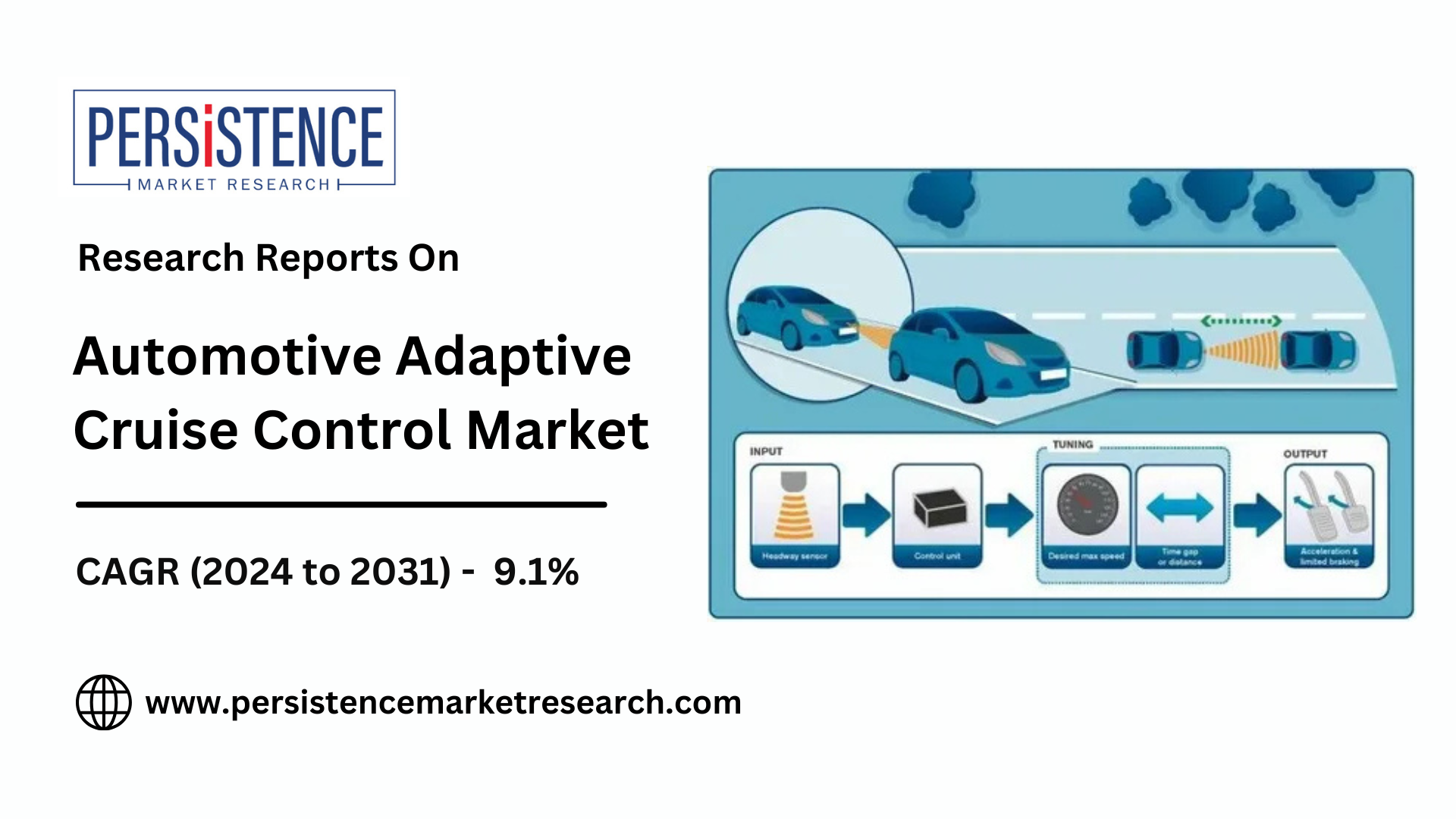Automotive Adaptive Cruise Control Market Set for Strong Growth Over Next Decade

Strong 8k brings an ultra-HD IPTV experience to your living room and your pocket.
The automotive adaptive cruise control (ACC) market is projected to grow from US$1.2 billion in 2024 to US$2.3 billion by 2031, with a CAGR of 9.1%. This growth is driven by the increasing demand for advanced driver-assistance systems (ADAS), road safety, and the rise of electric and autonomous vehicles. The Asia Pacific region is expected to dominate, thanks to its cost-effective production and technological advancements, particularly in sensors, radar systems, and AI. Collaborations between automakers and tech companies are enhancing ACC systems, and rising disposable incomes in emerging markets are shifting consumer preferences toward vehicles with advanced safety features. The European market is also growing due to regulatory support, with Germany leading innovation in ACC technology.
ACC systems, which automatically adjust a vehicle's speed to maintain a safe distance from the car ahead, have already become an essential feature in modern vehicles. As technology continues to advance, the scope and capabilities of ACC are expected to grow, offering more features such as lane-keeping assist, collision avoidance, and even semi-autonomous driving. This surge in growth is primarily being driven by innovations in sensor technologies, consumer preferences, regulations, and the ongoing shift toward autonomous vehicles.
Factors Driving the Growth of the Automotive Adaptive Cruise Control Market
Several key factors are driving the impressive growth of the Automotive Adaptive Cruise Control (ACC) market, positioning it as one of the most dynamic segments of the automotive industry.
1. Rising Demand for Enhanced Safety Features
One of the primary factors fueling the adoption of ACC is the growing consumer demand for enhanced vehicle safety features. In an era where road safety is paramount, consumers are increasingly looking for cars equipped with advanced safety technologies that can help prevent accidents and reduce the risk of collisions. ACC is a critical component of these safety systems, working in tandem with other ADAS technologies such as automatic emergency braking (AEB) and lane-keeping assist to improve overall driving safety.
By maintaining a safe distance from other vehicles, ACC helps reduce the likelihood of rear-end collisions, unintended acceleration, and driver fatigue, all of which are major contributors to accidents on the road. With regulatory authorities around the world setting stricter safety standards for vehicles, the implementation of ACC is expected to rise, driving market growth.
2. Advancements in Sensor Technologies
The rapid development of sensor technologies such as radar, LiDAR, cameras, and ultrasonic sensors is revolutionizing the performance of ACC systems. These sensors provide real-time data on the surrounding environment, allowing ACC to accurately detect and track nearby vehicles, pedestrians, cyclists, and other obstacles.
Radar sensors are commonly used in ACC systems to detect vehicles ahead, while LiDAR sensors are increasingly being integrated to provide high-resolution 3D mapping of the environment. Cameras also play a vital role in detecting lane markings, traffic signs, and other road elements. The continuous improvements in these sensors' capabilities, along with sensor fusion techniques that combine data from multiple sensors for more accurate decision-making, will enable more sophisticated and reliable ACC systems.
3. Automated and Semi-Autonomous Vehicles
The ongoing shift toward autonomous vehicles is another significant factor driving the growth of the ACC market. As vehicles move towards higher levels of automation, ACC is increasingly being integrated into semi-autonomous and fully autonomous vehicles. These vehicles rely on ACC to manage speed and braking while navigating in various traffic conditions.
The ability of ACC to automatically adjust the vehicle's speed based on the behavior of surrounding traffic is essential for enabling Level 3 and Level 4 autonomous vehicles, which require minimal human intervention. In these vehicles, ACC forms a core component of the autonomous driving system, making the market for ACC an important segment of the overall autonomous vehicle market.
4. Government Regulations and Safety Standards
Government regulations and safety standards are another major driver of the ACC market. In many countries, regulatory authorities are introducing new regulations that require the inclusion of certain ADAS technologies, including ACC, in new vehicles. For example, in the European Union, the introduction of EU Regulation 2019/2144 mandates the inclusion of advanced safety features such as ACC in all new cars by 2022. Similarly, the U.S. is exploring potential regulations that would require ACC and other safety technologies to be standard in new vehicles.
These regulations are expected to increase the adoption of ACC across regions, as automakers seek to comply with safety requirements and stay competitive in the global market.
5. Consumer Preferences for Comfort and Convenience
As consumers seek greater comfort and convenience, ACC systems are becoming an attractive feature in vehicles. Long-distance driving, highway commuting, and heavy traffic conditions can be physically and mentally demanding, often leading to driver fatigue. ACC alleviates this burden by automating speed adjustments and braking, providing a more comfortable driving experience. This feature allows drivers to relax, knowing that the system will adjust the vehicle’s speed and maintain a safe distance from other vehicles on the road.
This growing preference for automated driving experiences is expected to drive further adoption of ACC systems, particularly in higher-end vehicles and premium car models.
Market Outlook: Growth Opportunities in Key Regions
The Automotive Adaptive Cruise Control (ACC) market is expected to experience strong growth across various regions, with the Asia Pacific (APAC) region poised to lead the market due to increasing vehicle production, rising consumer demand, and rapid advancements in automotive technologies.
1. North America: Steady Growth in ACC Adoption
North America is one of the leading regions for the ACC market, driven by increasing vehicle sales, growing consumer interest in driver-assistance technologies, and the presence of key automotive manufacturers. In the U.S., ACC systems are becoming a standard feature in many mid- to high-end vehicle models, and the trend is expected to continue with the expansion of semi-autonomous and electric vehicles.
As consumer demand for safer and more convenient driving experiences rises, automakers in North America are likely to continue investing heavily in ACC technology, driving market growth.
2. Asia Pacific: Dominating Market Growth
The Asia Pacific (APAC) region is set to dominate the Automotive Adaptive Cruise Control market due to the rapid growth of automotive production, rising disposable incomes, and increasing demand for advanced safety features in vehicles. Countries such as China, India, Japan, and South Korea are witnessing a surge in vehicle sales and technological advancements, particularly in electric vehicles and autonomous driving technologies.
China, as the world's largest automotive market, is a key driver for ACC adoption, with both domestic and international manufacturers pushing the boundaries of ADAS technologies in response to regulatory changes and consumer demand.
3. Europe: Strong Regulatory Push for Safety Systems
Europe is another key region for the ACC market, driven by strong regulatory frameworks, technological innovations, and increasing demand for sustainable mobility solutions. European automakers are at the forefront of developing ACC systems, and the European Union's safety regulations are pushing for the wider implementation of ADAS technologies. Additionally, the European market is seeing significant interest in electric vehicles (EVs), which are likely to feature ACC as part of their driver-assistance and autonomous driving capabilities.
Conclusion: A Bright Future for Automotive Adaptive Cruise Control
The Automotive Adaptive Cruise Control market is set for robust growth, supported by advancements in sensor technologies, rising consumer demand for safety and convenience, and the increasing adoption of autonomous driving systems. As the market continues to evolve, ACC systems will play an increasingly integral role in shaping the future of the automotive industry, contributing to the development of safer, more efficient, and autonomous vehicles. With a projected 9.1% CAGR through 2031, the market is on track to witness strong growth across key regions, particularly in North America, Europe, and Asia Pacific, providing new opportunities for automakers, suppliers, and technology developers alike.
Note: IndiBlogHub features both user-submitted and editorial content. We do not verify third-party contributions. Read our Disclaimer and Privacy Policyfor details.







